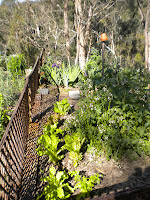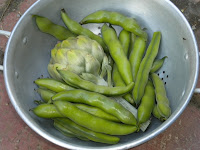Vita Sackville-West defined the art of the garden column for us and although she has many wonderful peers she was - and remains - one of the best writers about gardens and, more importantly, gardening.
You wouldn't think it's that hard to do, would you?
But good garden writing has to offer many things: clear word pictures; a strong and trusted, and hopefully entertaining, voice; expertise that comes from gardening, not just from books; and above all it is technical writing which can be devilishly tricky, especially if you don't realise that's what you're doing.
A dash of style doesn't go astray either.
Vita's writing is all of these and more, and people adored her columns in The Observer - even people who had no interest in gardening:
...The hedge is made of 'American Pillar', a rose which, together with 'Dorothy Perkins', should be forever abolished from our gardens. I know this attack on two popular roses will infuriate many people, but if one writes gardening articles one must have the courage of one's opinion. I hate, hate, hate 'American Pillar' and her sweetly pink companion 'Perkins'. What would I have planted instead? Well, there is 'Goldfinch', an old rambler, very vigorous, very sweet-scented, and when I say sweet-scented I mean it, for I do try to tell the exact truth in these articles and not mislead anybody. 'Goldfinch' is a darling, she is my pet, my treasure; a mass of scrambled eggs.
Vita, of course, was at heart a poet and writer and probably turns in her grave at the thought that her columns, rather than her huge body of creative work, is the writing for which she is remembered.
Local stars
Edna Walling, though not in the same camp as Vita (well, actually they were, but that's another story), was similarly revered for her wonderful, cranky columns which changed the way that many Australians thought about their gardens, and the bush:
A garden should, I always feel, be just a little too big to keep the whole cultivated, then it has the chance to go a little wild in spots, and make some pictures for you.
Edna is, if you like, the patron saint of the bush backyard.
At the same time, Bill Molyneux was writing about indigenous plants in lucid, passionate books that made us see the Australian landscape and its flora through new eyes, and his influence is evident in many contemporary writers about Australian plants, such as Diana Snape.
That's also why Peter Cundall is so adored by Australian gardeners. It's not that his prose has the poetry and dash of Vita's, because it doesn't; but he has a clear and dear voice and connects with both readers and viewers. We trust him and he is also not a bad technical writer (although I have read a passage of his on crop rotation many times and still can't make head nor tail of it):
I'm being terribly cruel to my tomatoes again. They are receiving just enough water to keep them alive... it's the best way I know to get them to produce early crops
That's even why Don Burke, love him or hate him, is so very popular. He has a distinct voice and, if you set aside his strange habit of advising companies on the wrong side of environmental debates, a reputation as trustworthy and knowledgeable. He may be many things but he's not boring.
But I have to say that many of their colleagues could blister paint with the dryness of their writing.
Several newspaper and magazine columnists make my eyes glaze over, lose focus, and move quickly onto the book review pages. A couple (we won't mention any names - Denise Gadd and Jim Fogarty) send my eyes rolling into the back of my head: I groan, and am incapable of even turning the page for a few minutes. It can't be that boring, surely?
In search of style
The issue rests in the idea that anyone can write. Of course that's true. Everyone can - to a point. But not everyone can write brilliantly. Even half-brilliantly. Even vaguely interestingly.
Not everyone who can garden can write about gardening.
Charisma can't be faked.
And charisma is what we need.
I know most of us don't spend too much time actually reading the words in our gardening books, unless we need to urgently find a cure for something. We're too busy drooling over the pictures.
Hands up those who have ever actually read a chapter by Hobhouse or Verey. I rest my case.
But the recent explosion of gardening book publishing has led to too many people who may be fine gardeners or affable enough on the telly being given advances and transformed into rock stars, when they should instead be given a copy of Vita's gardening column anthology and told to come back in a few years. I expect the same is true of cooking books.
In the new Australian book department, there are some honorable mentions: I actually read Jenna Reed Burns' Australian Gardens for a Changing Climate, while drooling, which tells us that the words must be meaningful and engaging, because the photographs are wonderfully distracting.
I do like Meredith Kirton's books, especially Dig. Marvellous production values, well thought-out, and her text is clear and snappy. There's not that much voice coming through, but you do feel her benevolent presence.
Michael McCoy is possibly the best popular garden writer in Australia right now. He never fails to amuse, whether in short columns or in books, and he has a lovely feel to him, if you know what I mean.
I adore Monty Don. He may be the love-child of Vita Sackville West and Beth Chatto. But don't let your mind linger on that thought too long. Get your grubby little green fingers on a copy of The Sensual Garden, or make someone give you Extraordinary Gardens for Christmas. That man can write. Even his TV shows are thoughtful and articulate.
(Which reminds me - why do those people on Gardening Australia speak to us all as if we were five? Have they done research that indicates we are all morons? Even John Patrick, a well-read and erudite writer and speaker, acts as if we were are all in some remedial class for people who've been wearing their gardening hats too tightly. And a few of them write in the same lifeless tone as well. I have ceased to read anything Jerry Coleby-Williams writes. I do hope it's paying John Patrick's mortgage, but I'd much rather read his really rather good books.)
Writers on gardening
It is salutatory that some of the best writing about gardens is by people other than garden writers: Germaine Greer, for example. Try to get your hands on The Virago Book of Women Gardeners (I have an illustrated edition, which is perhaps a mistake - if I want to actually read, I revert to my paperback, otherwise that drooling daydreaming thing happens).
Or perhaps The Nature of Gardens, edited by Peter Timms, with contributions from writers such as Carmel Bird, Marion Halligan and Belinda Probert. Carmel Bird points out this show-stopper from Maeterlinck, which proves my point completely:
Among the plants that has ceased to defend themselves, the most striking case is that of the Lettuce.
Timms also writes cultural histories of gardens and nature that prove that writing about gardens doesn't have to be dull as dirt.









